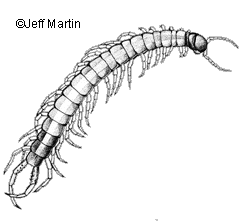Centipedes & Millipedes
 |
Centipedes are arthropods that have elongated bodies with one pair of legs per segment. They range in size from less than an inch to several inches. The giant desert centipede is usually 6 to 8 inches (15 to 20 cm) long, while the common desert centipede is 4 to 5 inches (10 to 13 cm) long. The larger giant desert centipede is orange with a black head and tail. This warning coloration advertises the centipede as dangerous. The smaller, brown and tan, common desert centipede is less so. While painful, neither bite is especially dangerous to humans.
Distribution
Centipedes are found world-wide, in temperate and, more abundantly, in tropical areas. These 2 desert species are found throughout the southern United States and into Mexico.
|
|
| Order: Scolopendromorpha |
| Family: Scolopendridae |
| Sonoran Desert species: giant desert centipede (Scolopendra heros), common desert centipede (Scolopendra polymorpha) |
| Spanish name: cien pies |
| Order: Spirostreptida |
| Sonoran Desert species: desert millipede (Orthoperus ornatus) |
| Other common names: rainworm |
| Spanish name: mil pies |
|
|
Ecology
Centipedes use structures called gnathosomes or gnathopods to inject venom into their prey. These are paired pincer-like appendages in front of the legs. The “bite” is actually a pinch. Centipedes are fast-moving predators that feed on any small creatures they can catch—mostly insects, but occasionally other arthropods, lizards, and even small rodents. Centipedes in the desert are strictly nocturnal and spend their days underground or concealed from the sun. They lack the waxy layer in their cuticle that other arthropods have, and are therefore more prone to desiccation than are other terrestrial arthropods.
Life History
Centipede mothers care for their eggs, coiling around them and grooming them. This grooming is thought to protect against mold and bacteria. Once the young hatch, the mother tends them as she did the eggs, until they disperse a few days later.
millipedes
 |
Millipedes have long, cylindrical bodies with 2 pairs of legs on each segment. New segments and pairs of legs are added each time the millipede sheds. Since it continues to grow and shed throughout its lifetime, it’s impossible to say how many legs a millipede has without counting. The common millipede in southern Arizona is a dark reddish brown, but millipedes in other areas may be tan to golden brown. Most desert millipedes are 4 to 5 inches (10 to 13 cm) long.
Distribution
Millipedes are found world-wide except in polar regions, but are more abundant in tropical climates.
Ecology
Millipedes are detritivores, foraging for decaying organic material (in the desert, generally in sandy washes). They are nocturnal and prefer humid environments, often appearing on roads after soaking summer thunderstorms. They are good burrowers and spend most of their time underground. If disturbed, the millipede rolls into a coil. If further threatened, it exudes foul-tasting chemicals from openings along the sides of its body. These noxious substances are the millipede’s only defense, since it doesn’t bite.
Life History
Millipedes are egg layers that do not care for their eggs or young. The eggs are laid underground or in some other concealed area. Millipedes can live 10 years or more.